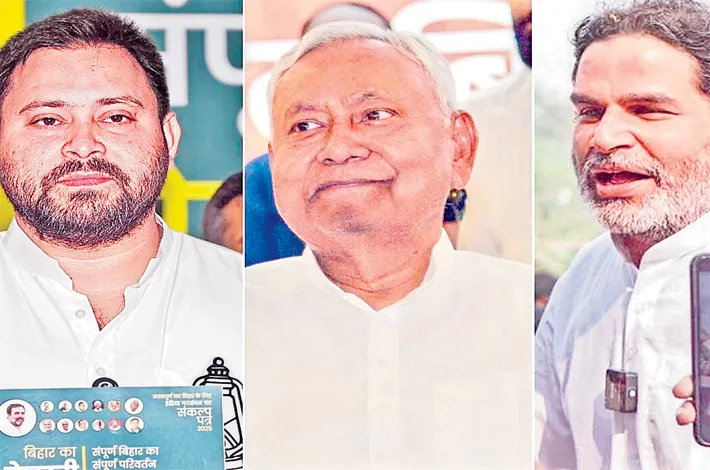Bihar votes in Phase 1: Will jobs and migration define the state's future?
08-11-2025 12:00:00 AM

Over 7.4 crore voters, including 1.4 lakh first-time electors, cast their ballots today in the first phase of Bihar's two-stage assembly elections, deciding the fate of 243 seats. Results will be declared on November 14. The contest pits the NDA, led by Chief Minister Nitish Kumar and the BJP, against the Mahagathbandhan under Tejashwi Yadav and Congress, with Prashant Kishor's Jan Suraj party adding a new variable to the electoral battlefield.
At the heart of the campaign lie two intertwined crises: chronic unemployment and mass migration. Bihar, which supplies millions of workers to India's factories, farms, and cities, remains mired in economic distress. Its per capita income stands at just Rs 32,000—less than a third of the national average—and the state ranks last on the Employment Condition Index. Despite some progress under Nitish Kumar's long tenure, one-third of Bihar's population still lives in poverty.
Both major alliances have made ambitious job promises. The NDA vows to create one crore jobs and establish skill centers in every district. The Mahagathbandhan counters with a pledge of one government job per family and unemployment allowances. Yet, voters remain skeptical, haunted by decades of unfulfilled commitments.
Why has Bihar lagged despite exporting India’s workforce?
Bihar origin corporate working in top positions in other parts of the country noted that while Bihar's per capita income has stagnated relative to India's growth—dropping from 40% of the national average at the century's start to about one-third today—the remittance economy now accounts for over 60% of household income, up from 35% in 2005.
"Bihar cannot become an industrial superpower," one of them argued, citing the loss of mineral-rich South Bihar (now Jharkhand) after 2000 and the state's landlocked geography. Some of them noted that Bihar’s greatest resource is its people—hardworking, resilient, and present from Kashmir to Kanyakumari. “But they remain stuck in low-value jobs: construction, delivery, warehouses." they lamented. They stressed the need for upskilling to move Bihari workers up the value chain, drawing a comparison with Kerala, where better education and health indicators enabled migrant workers in the Gulf to secure higher-paying roles.
Has the narrative shifted from caste to bread-and-butter issues?
A Political analyst observed a surprising shift in campaign rhetoric. She said that for the first time, jobs, healthcare, and education took center stage and that there was far less caste polarization or divisive talk—like the old firecrackers-in-Pakistan trope. However, caste remains the backbone of Bihar politics. Alliances continue to stitch together micro-caste groupings like a "political chessboard." The analyst called for land redistribution—upper castes still control vast tracts beyond legal limits—and warned that raised aspirations now demand delivery. "The next government will face intense pressure to perform."she predicted.
An economist speaking from the field painted a grim picture. "Rozgar (employment) is the biggest problem—and people have almost given up hope," he said. Migrants endure harsh conditions: cramped rentals in Mumbai or Ahmedabad, separation from families for 10 months a year, and overcrowded trains during festivals like Chhath Puja. He traced the state's struggles to the lingering Zamindari system post-independence, delayed social reforms, and the incomplete percolation of Mandal-era gains to Extremely Backward Classes (EBCs) and Mahadalits.
A social activist challenged the notion that caste politics alone holds Bihar back. While emphasizing that caste and communalism were national realities, he cited a recent caste-economic census showing 23% of Biharis earn under Rs 10,000 monthly. On job pledges however he was cautious. He pointed out that society yearns for change, but we’re stuck in a crisis of capitalism—capital flows in, but jobs don’t follow. He advocated special status for Bihar to attract public investment, noting the state’s recent Rs 10,000 dole to one crore women as short-term populism, not structural reform.
A Bihari origin HR professional highlighted the limited absorptive capacity of Bihar’s workforce in national job markets. He expressed regret that due to poor education and exposure,Bihari youth were confined to construction, warehousing, and delivery which he called as “the bottom of the pyramid.” He called for large-scale private investment to break the cycle: factories would create blue-collar jobs, raise wages, fund better schools and hospitals, and retain talent.
With votes still being counted, one question looms: Will Bihar’s ballot finally prioritize economic aspiration over political loyalty? What happens here will ripple far beyond the state—shaping how millions of Indians work, earn, and live.








